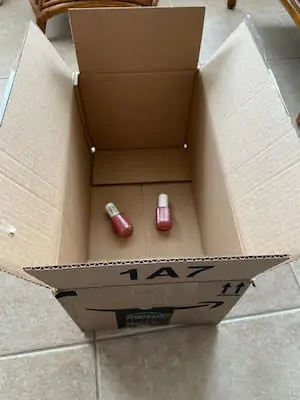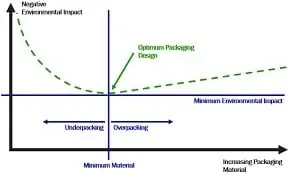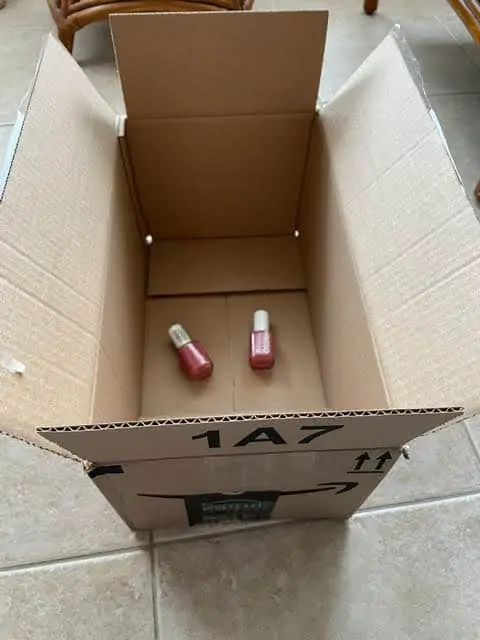My wife recently ordered some nail polish online from a VERY large online retailer. A few days later a large box arrived at the door. Rattling around in this large box were 2 small bottles of nail polish. The overpackaging was absolutely shameful and disgusting.
We’ve written about the topic before, and many years ago. And with all the talk about the environment, sustainability, recycling and waste elimination we would have thought the situation would have improved.
But at least one out of every 4 online orders we receive is subject to overpackaging.
This has to stop!
The Last (or at least the Latest) Straw!
The nail polish example is just one in a long, long line of packages we’ve received from online retailers for which the packaging is far in excess of what is necessary for the goods being shipped.
The 2 standard bottles of nail polish together measure about 4 cubic inches in size. They are light and not likely to break, and fairly inexpensive.
The box that these 2 bottles of nail polish were shipped in measured 7.5″ x 8.5″ x 14.5″. The box measured 925 cubic inches.

That’s right. The box was 230 TIMES bigger than the goods in side. Not double the size. Not 10 times the size. But 230 times bigger!
There really is no excuse for this blatant disregard for anything decent. The bottles could easily have been placed in an envelope, let alone a much smaller box, and been shipped without incident.
Most of the time when there is overpackaging it is not this excessive. The first time we wrote about this was over 4 years ago in “Last Mile Delivery: Stop Shipping Air and Empty Boxes!”
But the problem persists. This is not rocket science. So why does this problem persist?
Why Did This Happen?
The number one reason why this occurs is lack of management focus, concern and attention. Let’s just call it what it is.
There are plenty of reasons to minimize, if not eliminate, overpackaging:
- FedEx and UPS charge based on dimensional weight, not physical weight, so overpackaging costs a lot more money in shipping fees.
- The extra packaging material costs more money.
- Bigger boxes require more material handling effort, which takes more time and money.
- Bigger boxes take up more space in warehouses, in trucks and even in the reverse logistics chain
- Customers are highly frustrated by receiving multiple packages when fewer would do, and they are frustrated by the very visible waste of overpackaging. All of this harms the customer experience at the very last inch of the delivery process.
- The use of excessive materials is a waste of natural resources and is environmentally harmful
- The ability to sustain this level of waste is limited.
- All of this harms bottom line profitability and undermines any attempts at Corporate social responsibility
All of these reasons are sufficient to get the attention of management, and employees for that matter. But if management is not focussed on the issue, if they are more intent on shipping volumes of products at any cost, if they do not optimize their business processes, if they do not measure and track this situation, and if they are not held accountable then reckless overpackaging persists and prevails.
I would expect that optimizing business processes around packaging, providing employees with multiple packaging options, training those employees, measuring performance, and enforcing compliance, would address the overpackaging problem.
That doesn’t sound complicated at all. So why does overpackaging happen? Once again it is because management doesn’t care.
What Problems Does it Cause?
There are many obvious problems that overpackaging creates beyond the damage to the customer experience and confidence in the company shipping the goods.
Excess packaging is a clear waste of the physical materials that are used, along with the resources used to manufacture those materials in the first place. Overpackaging takes more time and effort to handle and move, not only in the distribution centers, but every time the box is moved from truck to truck to truck.
When boxes are larger than they need to be they take up more space in the delivery vehicles used to transport those goods. That means those vehicles take fewer packages then they could, and they end up using more fuel than necessary because they have to take more trips than are necessary.
Theoretically if all packages are only 10% larger than required, Ecommerce companies are spending 10% more in materials and fuel and effort than is necessary. That has a huge impact on the environment on financial performance. Now remember that in our real life example the package was 230 times bigger than it should have been.
When resources are constrained, whether it be in the era of restricted logistics capacity during the pandemic, or in the acquisition of resources during the incredible Black Friday-Cyber Monday period, any waste or excess is intolerable. There are no extra trucks, there are no extra people, and there are no extra raw materials to sustain this type of environmental abuse.
It is also immaterial whether the goods are recyclable or not. Sustainability first and foremost necessitates the elimination of overconsumption and waste in the first place. Thereafter the focus should be on re-use and recycling for whatever is generated.
The Soras Curve captures the concept that there is an optimal packaging design point. You can under package and under protect your goods as much as you can overpackaged.

What Can Be Done to Stop this?
Companies and management need to wake up. Overpackaging is clearly a result of a lack of management attention, focus, measurement, and action. It doesn’t take a rocket scientist to see that putting 2 tiny fingernail polish bottles in a huge box is a clear case of stupidity in action.
Employees at these companies are the next in line to stand up. Our example is so obviously wrong to anyone. Employees need to have the courage to stop this, to make recommendations, to bring this to management’s attention, and to do the right thing.
Finally, customers need to stand up and be heard. The best way to vote is with your wallet. If a company persists in this horrific behaviour, then take your business elsewhere. And let the company know why.
We are all in this together. This should not be a difficult problem to solve. It’s good for the environment, it’s good for the customer experience, and it’s good for the company’s operational and financial performance.
Stopping overpackaging is a win-win-win scenario.
So let’s stop overpackaging, and let’s stop tolerating overpackaging, NOW!


